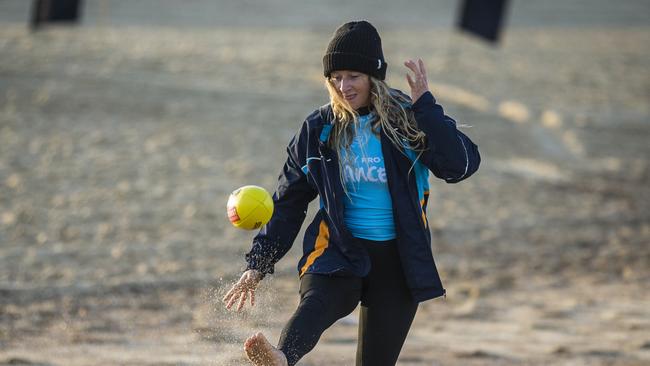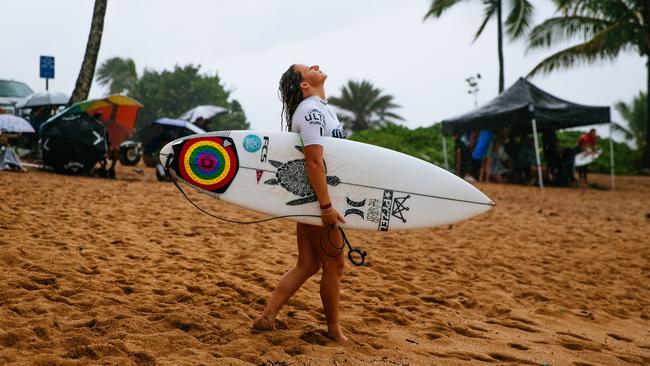India Robinson on concussions and her comeback to WSL tour
India Robinson discusses her comeback to the tour after her serious concussions and her motivation to be as successful as possible in order to keep her passion as her career.

Other Sports
Don't miss out on the headlines from Other Sports. Followed categories will be added to My News.
Far from daunted from her frightening head injury at Pipeline, emerging Australian surfer India Robinson is headed back to the famed monster swells of Hawaii this weekend because, frankly, her livelihood is at stake.
The 22-year-old rising star out of the NSW North Coast will resume her World Surf League journey at the Haleiwa Bay Challenger Event just over 12 months after her career and life threatening concussion at the infamous Banzai Pipeline.
Unlike some of her rivals who enjoy lucrative endorsements, competition is life for Robinson because she has had no major sponsor since she was 16.
Robinson dropped her most recent major surf brand sponsor six years ago because – in her words – “I didn’t want to put my bum on Instagram. I wanted my surfing to do the talking.”
But her stance against objectifying herself to build a social profile to increase brand awareness for would-be sponsors comes with its disadvantages – morals don’t pay the bills and her only income is competition prize money.
“It is my job at the end of the day. If I’m not competing, I’m at a loss of money,” Robinson said.
While surfing on the top WSL tour means you’re competing for $US100,000 first prize purses, the challenger series peaks at $US20,000.
Robinson earned $US25,000 in prize money last year in Hawaii – but only broke even for the trip due to out of pocket expenses like flights, accommodation, food, car hire, insurance, entry fees and membership.
“If I had a sponsor, I’d be getting another 20 or 30 grand from that sponsor based on good results at each event,” Robinson said.

THE INJURY
It was November 2021; Robinson was training hard to earn one of 20 coveted women’s places on the WSL Tour when she fell in a seemingly innocuous wipe-out. Her surfboard slammed into her temple and a familiar darkness swamped her vision. It was the second serious concussion the young athlete had suffered in just five months.
“I instantly knew it was the same feeling, I really didn’t feel good,” Robinson said.
“After my first concussion, I was physically unable to move for six weeks. I felt paralysed. I was unable to walk, my whole body was sore and tired.
“When I hit my head in Hawaii, my mind was like, oh my god, I’ve done it again. I’ve blown it.”
Robinson had only just recovered from a board to the head at her home break in Pottsville on the NSW Tweed Coast five months earlier. That injury saw Robinson bedbound with migraines and nausea, completely lacking energy. She was confined to a dark room because of her sensitivity to light, unable to surf or even walk without losing her breath.
“The hardest part of it all was the mental side of things or having to sit in a dark room all day every day for six weeks. I wasn’t able to socially interact because that was just too taxing to talk to people,” Robinson said.

FIGHTING BACK
Pipeline has in the past been considered too dangerous for women to surf. The WSL only added the notorious Hawaiian break as a competition stop on the women’s tour for the first time in 2022.
Robinson was there early, preparing to compete for a world title alongside Sally Fitzgibbons and (now) eight-time world champion Stephanie Gilmore.
While long-term impacts of concussion are more often associated with contact sports like rugby and AFL, Owen Wright put a spotlight on brain injuries in surfing when he jarred his head at Pipeline in December 2015.
He took months to get back in the water and battled deteriorating physical and mental health before he could return to competing in 2017.
Robinson paddled back out at the 2021 Haleiwa Challenger event, just four weeks after her injury, and miraculously qualified for the 2022 WSL tour.

She proceeded to finish in the top 10 in every event while silently battling an ongoing syndrome known as dysautonomia, which sends her heart rate skyrocketing during exercise and drastically reduces her aerobic capacity and strength.
She narrowly lost to Gilmore twice in quarter-finals and fell off the main tour in May following the 2022 mid-season cut.
The Haleiwa Challenger will be her first event on the second-tier Challenger Series to try to earn her way back in as an injury replacement or wildcard in 2023.
Her health restored, she knows it’s a long grinding road back to the main tour.
But there won’t be trepidation, just the pure motivation of knowing she has to succeed in the water if she’s to have a career in the sport she loves.




